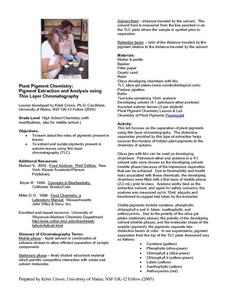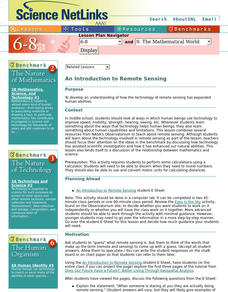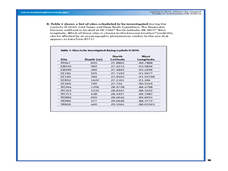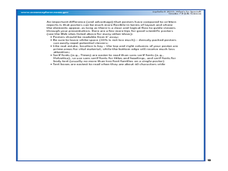Curated OER
What Are Ecosystems?
Third graders recognize and examine ecosystems. They observe and describe habitats within ecosystems and observe and identify organisms with similar needs that compete for resources.
Curated OER
How Cell Phones Work
Fifth graders are introduced to the text, LITERACY LINE viewing the contents page. They review the definition of explanatory writing; discussing the features used and complete a KWL chart to identify what they already know about how a...
Curated OER
Where'd You Get That Paper and Pencil?
Third graders make a poster display of objects made from trees. In this wood products instructional activity, 3rd graders read "The Giving Tree," discuss things that are produced from trees and watch the videos "Let's Make a Pencil," and...
Curated OER
Chlorophyll
Middle schoolers use thin layer chromatography, TLC, to separate various pigments found in plants.
Curated OER
Plant Pigment Chemistry
Students discover the roles of pigments present in leaves. They extract and isolate pigments present in autumn leaves using a thin layer chromatography. Very nice lesson and lab!
Curated OER
Meiosiss Revisited
Seventh graders are engaged in a lesson that covers the concept of meiosis with the intention of covered sexual reproduction. They cover the concept of genetic traits and how they are transmitted over generations with or without...
Curated OER
Habitats Worksheet
In this environment worksheet, students examine different types of animals that interact with the school environment and students write about some of the possible consequences for the animals.
Curated OER
No Fossils in This Fuel!
Students explain how technology leads to a cleaner environment. They gain hands-on experience with ethanol as a fuel alternative.
Curated OER
Seeing the World Through A Different Lens
Students participate in activities in which they model different disabilities. They discuss their experiences as a class. They work together in groups to discuss how to improve an adaptive device.
Curated OER
Extending Human Ability Through Technology
Learners explore how technology has been used to enhance human abilities. Using the internet, they watch a short video about prosthetics. They compare and contrast how prosthetics have changed over the years as technology has become...
Curated OER
Sampling Rocks
Young scholars study rocks they find on the playground. In this investigative lesson students collect and analyze rocks they find and answer questions about them.
Curated OER
Digital Wildflower Collection
Learners examine biodiversity and classify organisms. In this wildflower instructional activity students go out and take pictures of plants then create a presentation to show the class.
Curated OER
Who Has the Light?
Students study ways in which the ability to produce light may be useful to deep-sea organisms. In groups, they research and present to the rest of the class, how a specific organism is able to produce bioluminescence.
Curated OER
Atomic structure - Historical background
Students use the Internet to research the development of the discovery of the atom. They create an essay, PowerPoint presentation and a story line on the subject.
Curated OER
BIoluminescence
Students investigate the concept of bioluminescence. They use dinoflagellates in a lab situation to study photosynthesis. They conduct research into the concept using a variety of resources. Also the class is taken on a field trip to...
Curated OER
Meteor Monitor
Student's measure sporadic meteor activity. In this physics and astronomy lesson, 11th graders construct a dipole antennae, and build, test and wire a full wave diode rectifier between the dipole antenna and the laptop.
Curated OER
Let's Hit the Slopes!
Students study benthic communities in the Gulf of Mexico and explain their roles. In this investigative lesson students participate in a group activity and study how to calculate and index of biological communities.
Curated OER
Where's the Oxygen?
High schoolers study seawater and how temperature and salinity influence it. In this oxygen lesson students complete a lab activity on dissolved oxygen.
Curated OER
What's So Special?
Pupils study the biology and morphology of Lophelia corals. In this investigative lesson students explain how the coral contributes to communities, and create a poster.
Curated OER
Pendulum Clocks
Students use string, wire, weights, and a stopwatch to build pendulum clocks. In this pendulum clocks lesson plan, students use the pendulum clocks to investigate weather, climate, force, and motion.
Curated OER
Separation of Unknowns in a Liquid
Students identify the different components of a given sample using chromatography. In this chemistry lesson, students compare paper and column chromatography. They collect data and construct data tables.
Curated OER
A Limnology Study of Drainage Ditches
Learners chemically test water, observe microscopic organisms in the classroom, and screen the sample for macroinvertebrates. They design a reporting sheet that list all the items to be tested and a space to record the results.
Curated OER
Men in Space: From Goddard to Armstrong
Pupils view "Men in Space: From Goddard to Armstrong," taking a examine the the extraordinary lives of the men who conquered space.

























